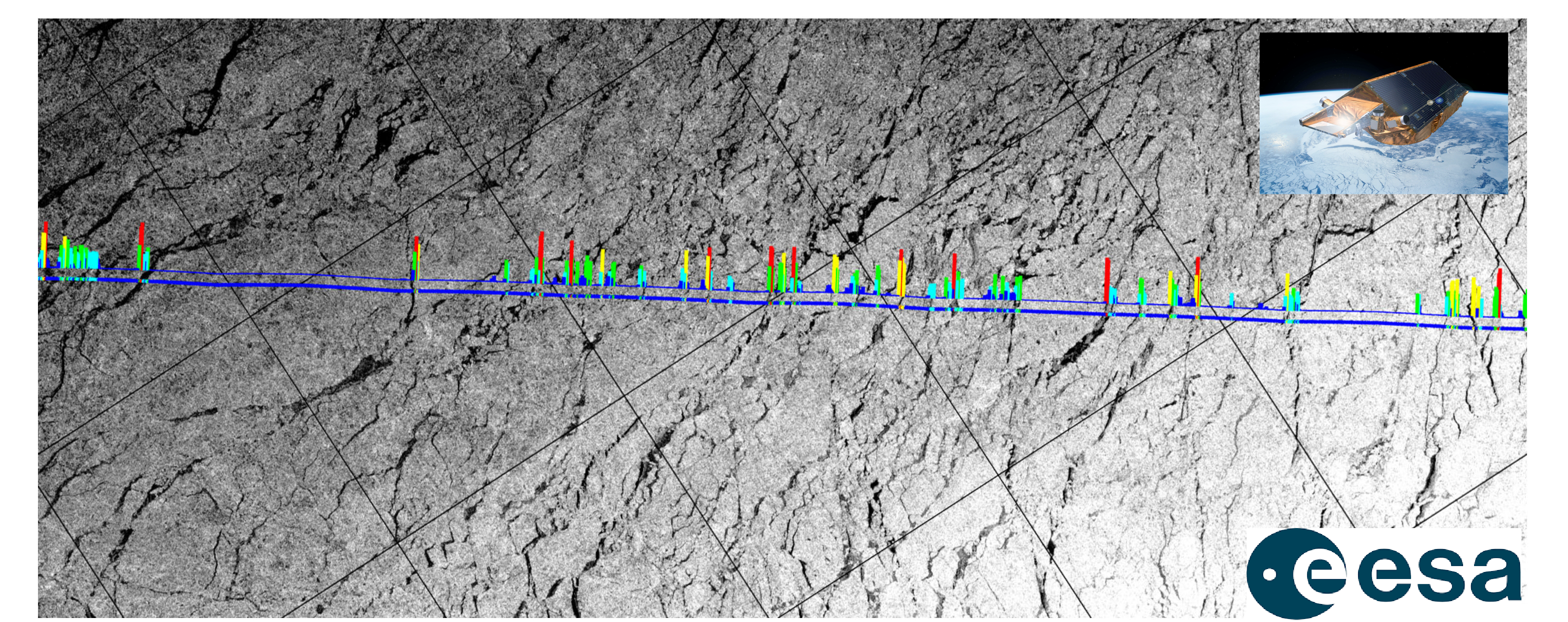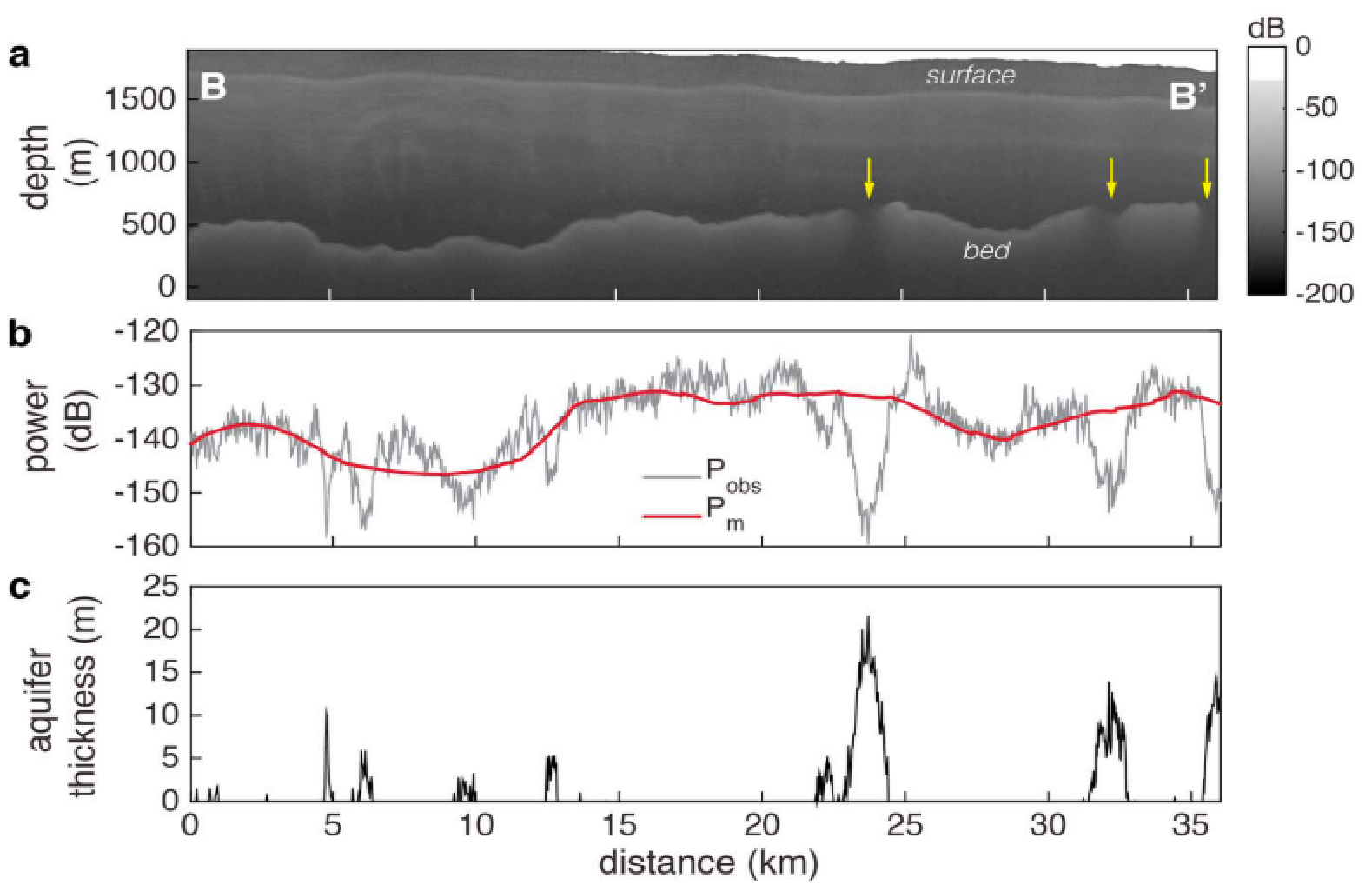My Academic Journey
My journey in polar sciences began far from the ice. Born in Hong Kong and raised in Worcestershire, UK, I discovered my passion for cryosphere research at the Centre of Polar Observation and Modeling (CPOM) at University College London (UCL). Under the mentorship of Dr. Seymour Laxon, I contributed to the early development of CryoSAT-2, learning to apply radar altimetry to measure Arctic sea-ice thickness as an undergraduate student.
 Fig. 1 The peakiness of received energy from CryoSat can tell us where there is open water (leads) between the floes of sea-ice (Credit: ESA/CPOM/UCL).
Fig. 1 The peakiness of received energy from CryoSat can tell us where there is open water (leads) between the floes of sea-ice (Credit: ESA/CPOM/UCL).
Dr. Laxon's encouragement led me to pursue a Ph.D. in Earth & Environmental Sciences at Columbia University. Under Dr. Robin Bell's guidance, I focused on using airborne ice-penetrating radar to characterize Greenland hydrology. A turning point came when I received the NASA FINESST fellowship, enabling me to explore research opportunities at NASA's Jet Propulsion Laboratory (JPL).
At JPL, mentors Dr. Dustin Schroeder and Dr. Helene Seroussi expanded my horizons, encouraging me to combine radio-echo sounding with large-scale ice-sheet modeling. This experience shaped my postdoctoral work in Dr. Schroeder's Radioglaciology Lab at Stanford University and ultimately led to my position as a tenure-track faculty member at Georgia Tech in 2020. Today, the synthesis of polar geophysics and numerical methods forms the foundation of our Polar Geophysical Simulation Lab at Georgia Tech, where my students and I continue to push the boundaries of cryo-geophysics research.
Research Interest
My research journey in polar sciences has evolved from studying glacier hydrology to developing innovative methods that synthesize radar sounding, AI technology, and numerical methods for analyzing ice sheet properties.

Glacier Hydrology: During my Ph.D., I used airborne radar sounding observations to study Greenland's subglacial hydrology system, conducting bed reflectivity analysis to identify basal water ponding locations. This work led to the realization that the variability of basal water storage beneath glaciers could play a crucial role in controlling seasonal changes in ice velocity and a glacier's response to surface meltwater input.
Radar Geophysics: As a postdoctoral researcher, I expanded this research to a larger scale across Greenland. To accurately interpret the radar bed signals at this scale, I delved deeper into radar signal processing, designing methods that combine bed reflectivity with other metrics like specularity content and trailing bed echoes energy, which are more sensitive to bed roughness changes than material contrast.
 Fig. 3 Radar attenuation can be used to detect englacial firn aquifers buried few meters beneath the Greenland Ice Sheet surface.
Fig. 3 Radar attenuation can be used to detect englacial firn aquifers buried few meters beneath the Greenland Ice Sheet surface.
Englacial Attenuation Analysis: This work also led me to investigate englacial attenuation, a significant uncertainty in bed reflectivity analysis. Factors like warmer or impurity-rich ice can lead to higher attenuation losses, potentially obscuring water ponding detection. Towards the end of my postdoc, I focused on using attenuation changes along radar survey profiles to constrain properties such as firn aquifer thickness and ice column temperature. This work not only improves the accuracy of subglacial water detection but also opens new avenues for using attenuation to constrain ice sheet properties that directly influence glacier dynamics.
Integrating AI and Ice Sheet Modeling: Currently, my research group is investigating the relationship between radar attenuation and ice temperature in Antarctica. We're using airborne radar attenuation data to calculate depth-averaged ice temperature, and a Ph.D. student, Donglai Yang working with me has developed an innovative approach using generative AI to estimate the probability distribution of basal temperature. Together with Postdoc, Dr. Eliza Dawson , we are producing a comprehensive map of Antarctica's basal temperature. By integrating it into large-scale ice-sheet model, Ice Sheet and Sea-Level System Model (ISSM), our goal is to significantly enhance our understanding of temperature-dependent basal slipperiness and its effects on ice flow.
Interest Beyond Research
Outside of my academic pursuits, I find balance and inspiration through a variety of activities. I enjoy camping and hiking, which allow me to recharge and escape the busy Atlanta Metro area. However, I also appreciate the comforts of home, where I spend evenings with my partner, engaging in PC gaming, cooking, digital art design, and home DIY crafting. I am an also avid reader and a passionate fan of science literature and science fiction, enjoying classics and contemporary works such as Star Wars, Star Trek, Stargate, Dune, and Ready Player One. These imaginative worlds fuel my creativity and curiosity, and help providing fresh perspectives that I bring into my research.
Contact Information:
